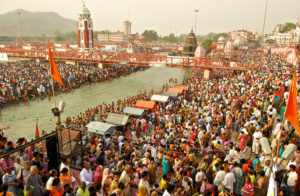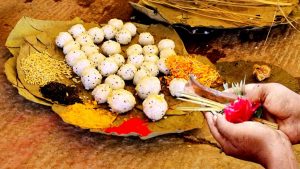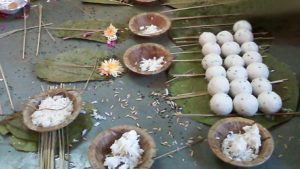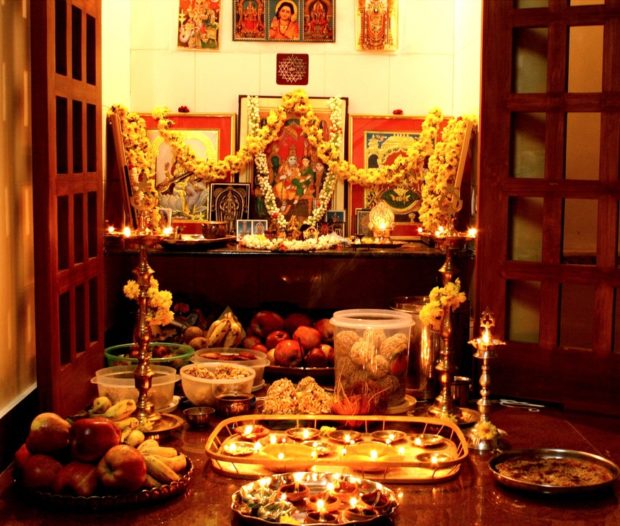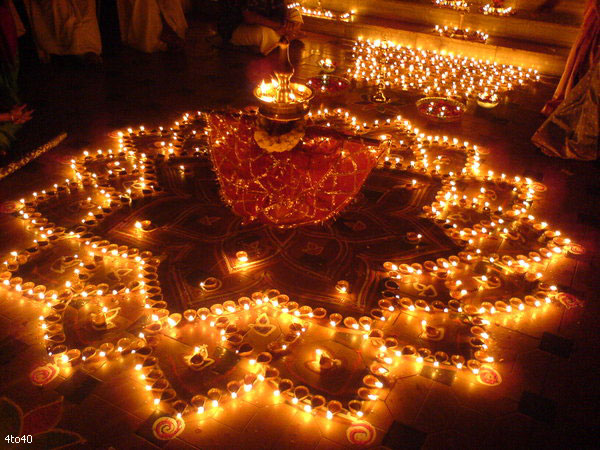How do people celebrate Karthigai Deepam?
This is a truly beautiful festival of peace and tranquility, with none of the feverish excitement of Deepavali. People settle the dust on the street in front of their homes by splashing thinned cow-dung to form a hard surface. They then draw beautiful kolam patterns with white rice flour and light small terracotta agal lamps. Women and children arrange these lamps on the outer kolam, in special crevices on walls and along terrace balconies until the whole facade twinkles with these pretty lights.
For some, this festival evolved as an extension of Deepavali. In some families, the tradition is to double the number of lamps they light every day from Deepavali until Kartikai.
Know more about the Karthigai deepam and its legend
Prepare, get organised and set up the house
- Arise early in the morning and have a regular head bath. Some people cook an elaborate meal in the morning after their bath, and make the neivedya offerings.
- Usually the family fasts in the morning, until moonrise. Others observe a vratam or vrata and eat a palaharam of fruits and milk or a simple meal without rice.
Preparing the lamps
The lighting of lamps is an integral part of Kartikai. Lamps are lit to dispel the darkness associated with ignorance and strife. People usually buy lots of new lamps for the occasion. There are innumerable varieties of lamps available these days: small traditional lamps wired with tiny flame-like bulbs; plug-in stream serial lights; lamps with inextinguishable flames; floating lamps in silver; lamps filled with candle wax; floating candles in a beautiful range of moulds; and agal candles; the traditional clay agal lamp made into a candle with a wick. Feel free to use all, illuminating the exterior of the house as beautifully as possible. As this is a full moon night, the pale radiance of the moon and the warm glow of the lamps make a spectacular combination.
As always, when handling Lamps, be careful
- The oil stains clothes easily, permeates granite and other porous surfaces. Take care to keep a rag handy to wipe your fingers and the outer surfaces of lamps that dip.
- Place a plate or a container under your lamps. Wicks chat are too long tend to drip oil on the floor and stain it.
- Flames and matches pose a fire hazard: be careful not to place the lamp too close to flammable surfaces and fabric. Children using matches should be supervised.
- Place lamps in sheltered locations, with the wick kept short so that the wind cannot knock the lamp over or blow the flame to flammablc surfaces.
- Set your lamps carefully so there is little chance of them getting knocked over.
- Caution children to lift the ends of their clothes when walking past the lights. Often they stand very close to these lamps, unaware that the ends of their skirts or clothes are brushing against the flames. Better still, place the lamps in the centre of a larger kolam and insist that the children walk around the kolam.
- Check your external electric sockets to make sure that the plugged electric lights are sheltered from inclement weather. Make sure there are no exposed wires that could cause a fire or a short circuit.
Getting Ready
- Get a large assortment of lamps ready. Retrieve all the lamps and lights in the house and clean them. The tall brass or silver kutti vilakku and other oil lamps should be cleaned as well.
- Purchase new earthen lamps. soak in water a little while so they do nor absorb too much oil, and dry them in the sun.
- Apply turmeric and kunkuma pottu on each lamp.
- Decorate the larger kutti vilakkus(traditional standing lamps) with flowers.
- Fill the lamps with oil and place a wick in each.
- Set the lamps on planks or salvers and place these in front of the pooja.
- Decorate the outside of the house with large and elaborate kolams.
- Draw beautiful, large kolams outside the house and inside, and along the walls like an edge motif.
- Make your neivedya.
Observance: auspicious things to do
In the Evening
- Usually it is better to shower again, although Once is enough if you have washed your hair in the morning.
- After 5 o’clock in the evening, light the kutti vilakku near the pooja.
- Perform a pooja for Murugan.
Preparing for the Kartikai Pooja
- Decorate the image or idol with
- Flowers
- Vastram (fabric and the cotton garland)
- Place the trays and planks with all the prepared lamps in front, along with betel leaf, betel nut, fruit, coconut, etc. and all the neivedyas.
The pooja
Perform a regular pooja. For those who wish to perform the pooja following a codified format, see Embracing the almighty.
- Place akshata and flowers on the deity.
- Perform the neivedya for Murugan.
- Break the coconut, light the camphor and do aarati.
- light all the other lamps (after sunset).
- Arrange all your lamps outside the house, on either side of your front door, along any balcony walls, parapet walls or exterior niches where they would be seen from the outside. Set some of them on the kolam outside the house and on the kolam in front of the pooja.
- Wait until the full moon rises, and make it a point to see the moon.
- Only after you see the moon, you can have dinner. It would be wonderful to make this an opportunity to have moonlight picnic. Some people eat only adai at night.
Daanam
Manjal kunkuma daanam
- All brothers must gift their sisters some betel leaves, betel nuts, yellow bananas, two pieces of the round dried turmeric root, and kunkuma. Along with this, a monetary or some other gift is expected, but left to the means and discretion of the brother. Women in turn pray for their brothers’ wellbeing during this festival.
- The first year after marriage , girls are given a ‘thalai Kartikai’ gift.
Reach us to be a part of our whatsapp spiritual reminder group
